Running with wolves
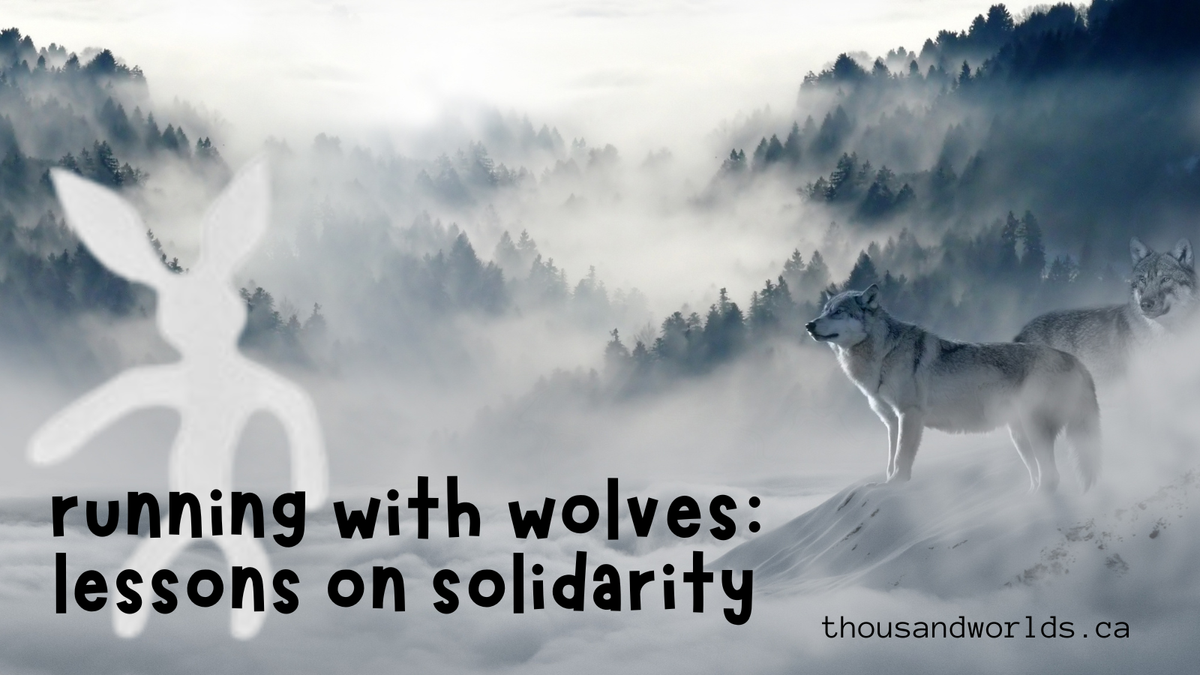
Nanaboozho, the wolves, and solidarity.
Today's story come from the Jones collection with some additional insight from Isaac Murdoch's Trail of Nanaboozho.
Having survived the winter with his pool of sturgeon, Nanaboozho spies some wolves off in the distance and decides to go with them. We learned in the quest for fire that Nanaboozho's brother (a stone) had rolled into the wolves' camp and become a wolf, so when Nanaboozho confronts the wolves about always acting like they don't know him, he tells the leader of this wolf pack that their father is his brother. Accepting their new uncle, the wolves tell him that they are off to a spot where they had cached some food and since, coincidentally, Nanaboozho just happens to be going there too they agree that Nanaboozho can come with them. In Murdoch's telling they laugh at him and say that he'll never be able to keep up so he retorts that his father is the West Wind and eat my dust. Jones mentions this in one of the versions he documented, and even in the ones that don't mention it, he takes the time to point out that Nanaboozho could hardly keep up.
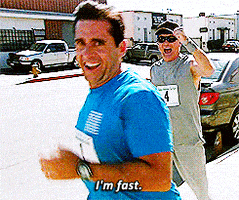
Being early spring the nights are chilly and Nanaboozho has not planned well, so when they all curl up, he's a little chilled and the old wolf asks him if he is cold. Having learned something from his engagement with the manitou Nanaboozho admits that yes, he is cold, so the wolf tells the younger ones to cover him with their tails. Later in the night he throws them off, complaining about "old dog tails," because he's become overheated but when he gets chilled again he's ok with the tails covering him.
Then, in another parallel with his engagement with the manitou, the wolf has him build a fire, which it seems he cannot because the old wolf tells one of his sons to kindle the fire. The younger wolf leaps over the kindling stacked by Nanaboozho and a fire lights up. They continue their journey and when they arrive at the cache we come to the third parallel: do not look at the things you have been given until morning.
Of course he looks. This is Nanaboozho. He looks, he takes a big bite out of what he thinks is moose-gut, and in the morning his nephews have a good laugh at him insisting he did no such thing while his bitemarks in the firewood tell a different story. They laugh, but they feed him from the cache anyway. There are two instances of Nanaboozho failing to see what is in front of him because he chooses to trust his eyes rather than his nephew, and then we get to the final act in which they are boiling the bones for marrow.
The old wolf tells him not to watch, which of course Nanaboozho does, and while he is watching the old wolf, a bone slips from the wolf's mouth and hits Nanaboozho in the eye which suggests that our manitou must have been maneuvered himself awfully close. The younger wolves tend to him and Nanaboozho denies watching, just like he denied eating what he thought was moose gut. Then he takes his turn and while nobody is watching, he takes a bone and strikes the old wolf, killing him. Just as the old wolf had done, Nanaboozho calls out to the younger wolves to revive him and the old wolf is restored to life. Again, Nanaboozho denies doing what he clearly did and in another version of the story it was a younger wolf that Nanaboozho strikes and the old wolf, with some trust issues of his own, had seen. I'll note for a moment that this business of people dying and being restored to life is commonplace in our stories. It's welcomed by the others in the story for sure, and is not typical, but it is not seen as particularly extraordinary either.
There's some back and forth about who was watching what and whether Nanaboozho's actions were intentional. They agree to part ways and the old wolf allows one of the younger wolves to go with Nanaboozho. The stories vary on whether this is just an offer by the old wolf or if Nanaboozho asked first but either way this is how Nanaboozho winds up traveling with a wolf.
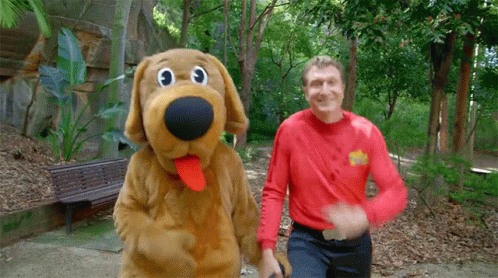
There's a pretty funny aside in Jones' versions about Nanaboozho running without a tail and deciding to use his penis as a tail. In one version the wolves tell him to pack it in because it smells awful which is funny given what he said about their tails when he woke up all sweaty from sleeping under the fur. The wolves definitely have a sense of humour, which I think you need if you're going to be friends with somebody like Nanaboozho.
I was curious why this appears in two versions of the story, and I remembered that one of my teachers has said that when there's something sexual to pay attention because it's pointing you towards something important. According to the google machines, wolves, coyotes, and dogs all use their tails differently when they run. Coyotes run with their tails down, dogs with their tails up, and wolves with their tails straight out. The story doesn't specify the direction of Nanaboozho's penis, but I think we can infer it was sticking straight out because my suspicion is that Nanaboozho, being the keen observer that he is, would have noticed that coyotes, dogs, and wolves all use their tails differently. Perhaps he did this to avoid being mistaken for a coyote, perhaps he did it because he wanted to fit in. Maybe both.
And somehow this story becomes a story about solidarity.
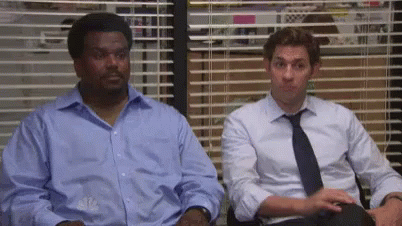
The wolves themselves clearly know who Nanaboozho is, so this wasn't for their benefit. It was for those who may be watching from a distance, those who don't know us well enough to know who we are without the various ways that we mark ourselves. And as delulu as Nanaboozho can be at times, I don't think he believed that anyone watching from a distance or otherwise would think that he was actually a wolf. I mean, there's a lot more to looking like a wolf than sticking your penis out while you run. And since Nanaboozho can shape-shift, why not just do that if being seen as a wolf was his goal?
Because maybe making others think he was a wolf was not his goal. Maybe he was just showing anyone watching, and watching is a big theme in this story, whose team he was on.
I think about the ways that I mark myself. Big beaded earrings. Ribbon skirts. I have one skirt that I wear for every speaking engagement now because with the ribbon and applique it evokes a Palestinian flag. When I go to rallies for Palestine I generally wear a ribbon skirt so that watchers know that an Indigenous person is present.
The first time I spoke on a stage after October 7, 2023 was on October 8 and I did not bring Palestine with me. The church that had invited me had asked me not to say anything about queer people and I reasoned that if they didn't want to hear about queer people they wouldn't want to hear about Palestinians either so I made some veiled references but gave in and it still guts me that I did that. The next time I spoke was later in November at a large conference for people working with migrants and refugees. I wore a keffiyeh and took the stage after the deputy minister of immigration to deliver my keynote. She did not answer one of the questions posed in the Q&A app about Palestine, so I took the opportunity to answer it myself. And I've brought Palestine (and Congo and Kurdistan and El Salvador and everybody else including queer folk) on stage with me ever since.
Was I nervous?
OMG yes. Very nervous. Very aware of people watching, friendlies and not so friendlies. Aware that my livelihood could be impacted by people who wouldn't want to risk putting me on their stages. But I keep doing it and without exception, there are some who take the trouble to wait in line, or send me a private message to thank me and tell me that they felt seen.
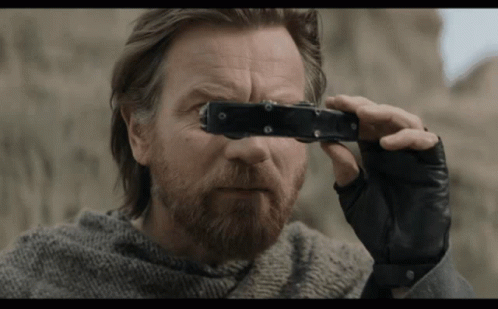
Watching. It's a big theme in this story. Nanaboozho watching the wolves in the distance and running to catch up to them. Nanaboozho and the wolves watching each other. Unidentified watchers noticing the man running with his penis sticking straight out behind him. It may sound like a ridiculous element to include in the story, a moment of comic relief perhaps, but it's more than that. Nanaboozho must have watched wolves, coyotes, and dogs for a while to understand the differences and then chose which of those differences he could incorporate to show solidarity.
Some of those who take the trouble to talk to me after a presentation are themselves Palestinian, others have friends or relatives. All of them recognize the keffiyeh and the ribbon skirt as a sign of my politics but I can't just leave it there. Marking ourselves all the ways that we do is part of how we signal our intentions to others but in isolation these markings don't mean anything. Urban Outfitters used to sell Tshirts with Che Guevera on them and I doubt that everyone wearing one of those is an anti-capitalist revolutionary. The meaning comes from our actions, from the things that we say and do that either align or don't with the ways we have marked ourselves.
Of course, we aren't the only ones waving our dick around and pointing it into the air for those who are watching. During the inauguration festivities Elon Musk signalled something very clearly with his arm in the air, twice no less. Once towards the audience and again towards the newly sworn in president. While the internet is awash in debate over whether or not he intended what we all clearly saw, I think they're missing the point. Since we can't know what somebody intends, we get bogged down in the wrong questions.
I am far more interested in what it signals to the watchers, what it means that he, somebody who openly supports neo-nazi politicians and social media accounts, did this so unambiguously. I am concerned that it will be seen by white nationalists as a kind of bat signal reassuring them of who is charge now. Reassuring them of whose deaths and disappearances will not be investigated in the midst of Executive Orders targeting migrants through citizenship, the southern border, and tariffs exerting financial pressure on other countries to bring their own immigration policies in line with an openly fascist US. Orders and signals that are worrisome because the US has a long history of citizen militias protected by the second ammendment who see themselves on the front lines of defending their country from enemies, domestic and foreign.
Populism is a political belief that emphasizes the idea of the common people in opposition to elites. This applies to a whole range of beliefs across the political spectrum.
Back to our story.
Solidarity is about more than wearing buttons and signalling our intentions. It's about how we live with each other and the actions that we take. As always, Nanaboozho offers us a mixed bag of examples to learn from. In some ways he works well with his wolf-relatives and in others he does not, most obviously in his retaliation against the older wolf. What was presented as accidental on the part of the wolf is, at least in two of the versions, clearly intentional when Nananboozho does it and we have to think about that. We have to think about the harms that are done in solidarity work, and how we react to being harmed. In this the actions of the wolves offer us much better lessons than Nanaboozho, which stands to reason since they live in a pack and he's more of a loner.
The wolves take care of him and feed him, they teach him how to make fire and use humour to push back against his rudeness. Though he kills the old wolf, they are able to repair the damage and even while they part ways they still take care of him. Nanaboozho accepts the separation but asks if one of his nephews can stay with him promising that nothing harmful will happen. The old wolf agrees, saying that he knows Nanaboozho is a manitou. In one version, the old wolf also gives Nanaboozho fire, flint, and kindling which he will light by leaping over it the way that the wolf had done earlier. In another Jones prefaces the decision to part company with the observation that Nanaboozho was somewhat disliked, an unsurprising outcome all things considered.
This is going to happen in solidarity work. We're not always going to get along and we have to work out how we will manage the inevitable harms as well as where our limits are. What can we manage with care and teaching, when do we simply have to part ways, and what do we put into place to ensure everybody's safety. Movement building isn't always about being together forever and it definitely isn't about organizing only with those with whom we share everything. Sometimes it means organizing towards a shared goal alongside others with whom we have real political disagreements. All of these things matter and this story contains so many lessons on how to think through the messiness of life together.
Finally, I think it is important that Nanaboozho did not just shape-shift into a wolf while he was hanging out with them. Unlike his brother, the stone, who was adopted and became a wolf, he stayed himself, flawed and messy as he is. That's what we do. Even while we chant that in our thousands, in our millions we are all Palestinians we don't mean that we are actually Palestinian. We are connecting our struggles together. We are recognizing that this colonial, capitalist system is coming for all of us and that whatever safety marginalized people might experience is precarious, it can be swept aside with the stroke of a pen.
Build those networks of solidarity and take a stand. In January people love to quote Martin Luther King, love to quote his brotherhood and light comments, but it was his anticapitalist politics that got him assassinated and it was his letter from Birmingham Jail that castigated the white moderate who refused to stand for anything but the status quo.
Time to let your freak flag fly and unambiguously show everybody whose side you are on.
Loaded: A Disarming History of the Second Ammendment. This book by historian Roxanne Dunbar-Ortiz offers a brief but very instructive history of the second ammendment, providing important context within the Indian Wars, Slave Codes, and the war with Mexico. In this current political climate, knowing this history feels particularly important.
Safety Through Solidarity: A Radical Guide to Fighting Antisemitism by Shane Burley and Ben Lorder. Such a good book to help us understand what antisemitism is, and isn't, how it is weaponized in our current political climate, and how solidarity keeps us all safe. I first heard of Burley through the Movement Memos podcast and he's been there a few times to talk about neonazis and fascism in the US.
The World We Used to Live In: Remembering the Powers of Medicine Men by Vine Deloria Jr. Posthumously published work by Deloria, a lawyer and activist academic who, after decades of arguing passionately for the legitimacy of Indigenous spirituality without engaging substantially in it's practice, compiled a volume of mostly first person accounts describing the power of medicine men throughout Indian country, before and after colonization. This description of him written by his son in the foreword, arguing passionately without engaging substantially, hit home for me. For a long time I've said that I was the least mystical Indian you'll ever meet, but that's increasingly untrue and I find myself longing for this world we used to live in. A world where we could communicate with the life all around us and have it communicate back.
Of Living Stone: Perspectives on the Continuous Knowledge and Work of Vine Deloria Jr. edited by David E. Wilkins and Shelly Hulse Wilkins. This volume brings together artists, activists, and academics to reflect on the legacy of Vine Deloria Jr. There are expansions and critiques, all of them writing about the foundational work he did alongside so many others that make the contemporary work of Indigenous activists possible.
Be sure and let me know you are coming so I can turn on the zoom room.

And don't forget to join up with the Nii'kinaaganaa Foundation. Every month we collect funds from people living on Indigenous land and redistribute them to Indigenous people and organzers. You can find out more information on the website which is now powered by ghost, which means that you can become a subscriber there just like you are here!
